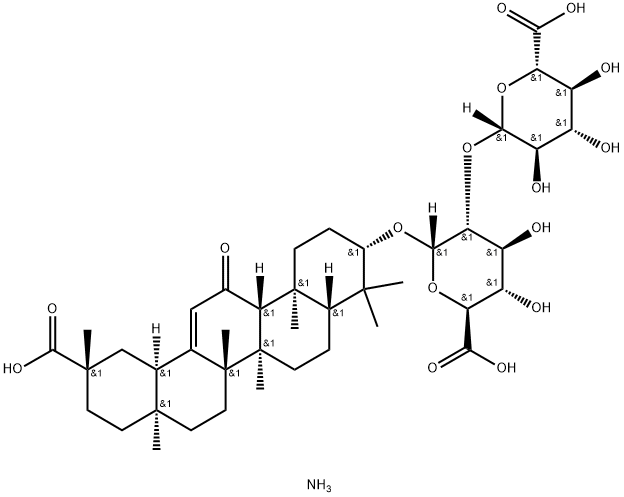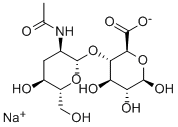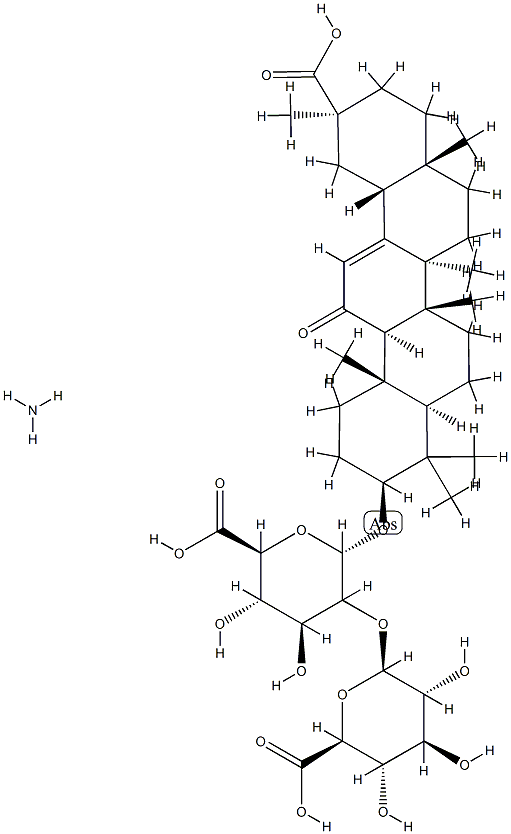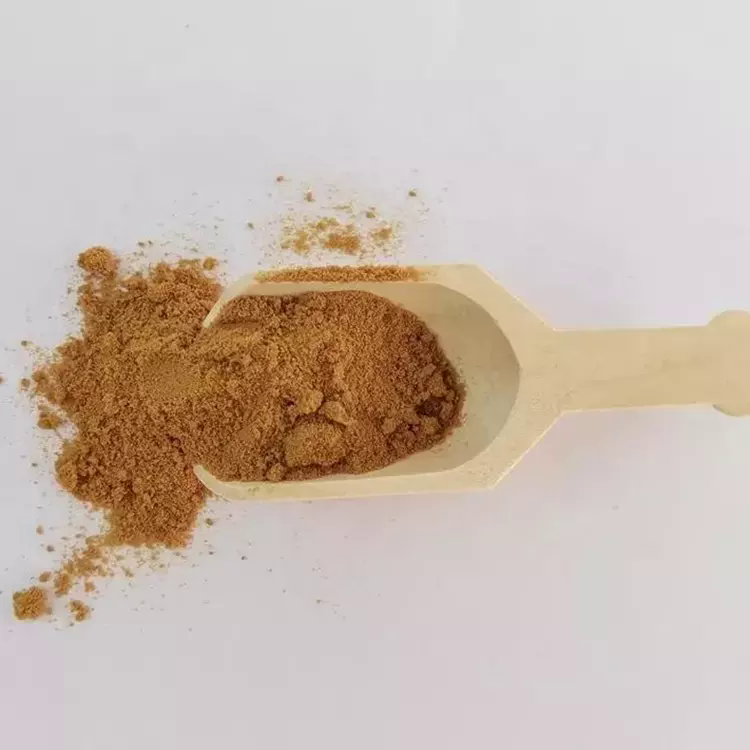Glycyrrhizic acid ammonium salt
Synonym(s):3-O-(2-O-β-D -Glucopyranuronosyl-α-D -glucopyranuronosyl)-18β-glycyrrhetinic acid ammonium salt;Glycyrrhizic acid ammonium salt;Glycyrrhizic Acid, NH₄ +;Glycyrrhizin;Glycyrrhizin, Ammonium Salt - CAS 53956-04-0 - Calbiochem
- CAS NO.:53956-04-0
- Empirical Formula: C42H65NO16
- Molecular Weight: 839.97
- MDL number: MFCD00167400
- EINECS: 258-887-7
- SAFETY DATA SHEET (SDS)
- Update Date: 2024-12-18 14:07:02

What is Glycyrrhizic acid ammonium salt?
Description
§ 184.1408(a)(1) Licorice (glycyrrhiza) root is the dried and ground rhizome and root portions of Glycyrrhiza glabra or other species of glycyrrhiza. Licorice extract is that portion of the licorice root that is, after maceration, extracted by boiling water. The extract can be further purified by filtration and by treatment with acids and ethyl alcohol. Licorice extract is sold as a liquid paste ("block"), or spraydried powder. (2) Ammoniated glycyrrhizin is prepared from the water extract of licorice root by acid precipitation followed by neutralization with dilute ammonia. Monoammonium glycyrrhizinate (C42H61016NH45H2O ) is prepared from ammoniated glycyrrhizin by solvent extraction and separation techniques.
Chemical properties
white to slightly yellow powder
Chemical properties
Licorice (glycyrrhiza) root is the dried and ground rhizome and root portions of Glycyrrhiza glabra or other species of glycyrrhiza Ammoniated glycyrrhizin is prepared from the water extract of licorice root by acid precipitation, followed by neutral- ization with dilute ammonia Monoammonium glycyrrhizinate (C42H62O16NH45H2O) is prepared from ammoniated glycyrrhizin by solvent extraction and separation techniques.
The Uses of Glycyrrhizic acid ammonium salt
Glycyrrhizic acid ammonium salt is a flavoring and sweetening agent obtained from licorice flavonoids. It has a slight licorice flavor and an intense and rounded sweetness. It is soluble in water, glycerin, and propylene glycol and has good thermal stability but can degrade under prolonged heating. It is stable over a ph of 3.5–9 but could precipitate below ph of 3.5. It can be used in beverages, desserts, confectionary products, soups, and dressings.
The Uses of Glycyrrhizic acid ammonium salt
Ammonium Glycyrrhizinate is used in the synthesis of polyion complex nanocarriers which may act as a template for the design of other negatively charged water-soluble drugs. Particularly for anti-infl ammatory drugs with which Ammonium Glycyrrhizinate is associated.
The Uses of Glycyrrhizic acid ammonium salt
anti-cancer agent
The Uses of Glycyrrhizic acid ammonium salt
pharmaceutical excipient, GRAS, sweetener
What are the applications of Application
Glycyrrhizin Acid Ammonium Salt is a potent anti-viral agent
Definition
ChEBI: Monoammonium glycyrrhizinate is an organic molecular entity.
General Description
Produced and qualified by HWI pharma services GmbH.
Exact content by quantitative NMR can be found on the certificate.
Biochem/physiol Actions
Biologically active constituent in the sweet root of Glycyrrhiza species (licorice). Antiviral.
Anticancer Research
Glycyrrhizin (GL) is a saponin-like compound that provides the main sweet flavourfor G. glabra (licorice), and it is commonly used in clinical treatment for itsoutstanding pharmacological action such as antitumour, anti-inflammatory andanti-oxidativeactions (Rebhun et al. 2015; Wu et al. 2015). Cai et al. (2017) triedto evaluate the anticancer properties of GA and GL against TNBC in combinationwith etoposide.
Safety Profile
Moderately toxic by intravenous route. An experimental teratogen. Experimental reproductive effects. Mutation data reported. When heated to decomposition it emits toxic fumes of NH3.
Purification Methods
Crystallise the ammonium salt from glacial acetic acid, then dissolve it in ethanolic ammonia and evaporate. The pentahydrate forms needles from 75% aqueous EtOH, m 212-217o. The free acid crystallises from glacial acetic acid. [Karrer et al. Helv Chim Acta 4 100 1921, Lithgoe & Tripett J Chem Soc 1983, 1987 1950, Beilstein 18 IV 5156.]
Properties of Glycyrrhizic acid ammonium salt
| Melting point: | >200°C (dec.) |
| Boiling point: | 768.56°C (rough estimate) |
| Density | 1.1846 (rough estimate) |
| refractive index | 49 ° (C=1.5, EtOH) |
| FEMA | 2528 | GLYCYRRHIZIN, AMMONIATED (GLYCYRRHIZA SPP.) |
| storage temp. | 2-8°C |
| solubility | Slightly soluble in water, very slightly soluble in anhydrous ethanol, practically insoluble in acetone. It dissolves in dilute solutions of acids and of alkali hydroxides. |
| form | Powder or Crystals |
| color | Yellow to yellow-green |
| Odor | bland |
| optical activity | [α]20/D +48±4°, c = 1% in ethanol: water (1:1) |
| BRN | 3897076 |
| Stability: | Hygroscopic |
| CAS DataBase Reference | 53956-04-0 |
| EPA Substance Registry System | .alpha.-D-Glucopyranosiduronic acid, (3.beta.,20.beta.)-20-carboxy-11-oxo-30-norolean-12-en-3-yl 2-O-.beta.-D-glucopyranuronosyl-, monoammonium salt (53956-04-0) |
Safety information for Glycyrrhizic acid ammonium salt
| Signal word | Warning |
| Pictogram(s) |
 Exclamation Mark Irritant GHS07 |
| GHS Hazard Statements |
H319:Serious eye damage/eye irritation |
| Precautionary Statement Codes |
P264:Wash hands thoroughly after handling. P264:Wash skin thouroughly after handling. P280:Wear protective gloves/protective clothing/eye protection/face protection. P305+P351+P338:IF IN EYES: Rinse cautiously with water for several minutes. Remove contact lenses, if present and easy to do. Continuerinsing. P337+P313:IF eye irritation persists: Get medical advice/attention. |
Computed Descriptors for Glycyrrhizic acid ammonium salt
| InChIKey | ILRKKHJEINIICQ-YDYGGSECSA-N |
Glycyrrhizic acid ammonium salt manufacturer
Sunpure Extracts Pvt Ltd
Sami Sabinsa Group Limited (formerly Sami Labs Limited)
New Products
Tert-butyl bis(2-chloroethyl)carbamate 4-Methylphenylacetic acid N-Boc-D-alaninol N-BOC-D/L-ALANINOL N-octanoyl benzotriazole 3-Morpholino-1-(4-nitrophenyl)-5,6-dihydropyridin- 2(1H)-one Furan-2,5-Dicarboxylic Acid DIETHYL AMINOMALONATE HYDROCHLORIDE 1,1’-CARBONYLDIIMIDAZOLE R-2-BENZYLOXY PROPIONIC ACID 1,1’-CARBONYLDI (1,2-4 TRIAZOLE) N-METHYL INDAZOLE-3-CARBOXYLIC ACID (2-Hydroxyphenyl)acetonitrile 4-Bromopyrazole 5-BROMO-2CYANO PYRIDINE 5,6-Dimethoxyindanone 5-broMo-2-chloro-N-cyclopentylpyriMidin-4-aMine 2-(Cyanocyclohexyl)acetic acid 4-methoxy-3,5-dinitropyridine 1-(4-(aminomethyl)benzyl)urea hydrochloride 2-aminopropyl benzoate hydrochloride diethyl 2-(2-((tertbutoxycarbonyl)amino) ethyl)malonate tert-butyl 4- (ureidomethyl)benzylcarbamate Ethyl-2-chloro((4-methoxyphenyl)hydrazono)acetateRelated products of tetrahydrofuran



![5,8-Dihydroxy-2-[(1R)-1-hydroxy-4-methyl-pent-3-enyl]naphthalene-1,4-dione](https://img.chemicalbook.in/CAS/GIF/517-89-5.gif)




You may like
-
 53956-04-0 Ammonium glycyrrhizate 99%View Details
53956-04-0 Ammonium glycyrrhizate 99%View Details
53956-04-0 -
 53956-04-0 98%View Details
53956-04-0 98%View Details
53956-04-0 -
 53956-04-0 98%View Details
53956-04-0 98%View Details
53956-04-0 -
 Monoammonium Glycyrrhizinate CAS 53956-04-0View Details
Monoammonium Glycyrrhizinate CAS 53956-04-0View Details
53956-04-0 -
 Glycyrrhizic acid ammonium salt, from glycyrrhiza root, 70%+ CAS 53956-04-0View Details
Glycyrrhizic acid ammonium salt, from glycyrrhiza root, 70%+ CAS 53956-04-0View Details
53956-04-0 -
 Glycyrrhizic acid ammonium salt, from glycyrrhiza root, 95%+ CAS 53956-04-0View Details
Glycyrrhizic acid ammonium salt, from glycyrrhiza root, 95%+ CAS 53956-04-0View Details
53956-04-0 -
 Ammonium glycyrrhizate CAS 53956-04-0View Details
Ammonium glycyrrhizate CAS 53956-04-0View Details
53956-04-0 -
 733039-20-8 5-broMo-2-chloro-N-cyclopentylpyriMidin-4-aMine 98+View Details
733039-20-8 5-broMo-2-chloro-N-cyclopentylpyriMidin-4-aMine 98+View Details
733039-20-8